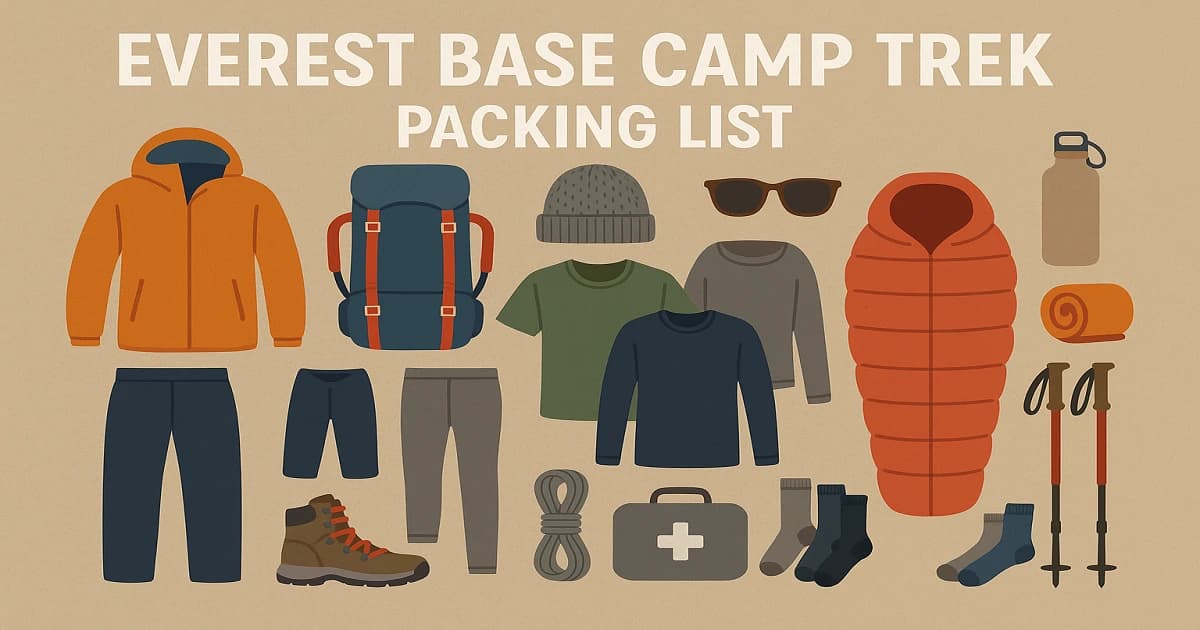Trekking to Everest Base Camp is a dream adventure for many travelers and trekkers around the world. The adventure takes you on a trek through picturesque Sherpa villages, ancient monasteries, and surreal Himalayan surroundings. This adventure to the foot of the highest mountain on earth is a test of endurance, spirit, and preparation. One of the main things that determines the success and comfort of your adventure is what you pack. A well-prepared Everest Base Camp Trek packing list warrants your readiness for the high-altitude adventure. In this detailed guide, we’ll break down everything you need so that you can enjoy the adventure with confidence.
Why should the Packing List be Right for the Everest Base Camp Trek?
Unlike other shorter adventures or low-altitude treks, the Everest Base Camp Trek takes you above 5,000 meters. The temperatures and weather conditions at this elevation can change dramatically and quickly.
A well-packed backpack makes sure that you:
- Stay warm, dry, and comfortable
- Have a manageable backpack load in the mountains
- Have the necessary stuff to handle situations at the high altitude
- Lessen the possibility of forgetting key items that you don’t find along the trail
How much should your Bag Weigh?
It can be quite challenging to carry a heavy backpack in the mountains. So, you should make sure that your main backpack has a weight of 10–12 kg and the daypack has 3–5you’re your There will be a porter to carry your backpack where you should carry the daypack. The lighter you pack, the better you enjoy the adventure.
Clothing: Layering is the Key
Since conditions in the Everest Base Camp Trek varies from hot sunny days to chilly nights, layering allows you to adjust easily. Here’s a breakdown:
Base Layers (Moisture-wicking)
- 2–3 thermal tops (synthetic)
- 2 thermal leggings
These form the foundation for warmth and help wick away sweat.
Trekking Shirts
- 3–4 quick-dry t-shirts (mix of short and long sleeve)
Avoid cotton as it retains moisture.
Mid Layers
- 1 fleece jacket or pullover
- 1 lightweight down or synthetic insulated jacket
Outer Layers
- 1 waterproof, windproof shell jacket (with hood)
- 1 waterproof pair of trekking pants
These protect against snow, rain, and wind at higher altitudes.
Trekking Trousers
- 2 pairs of trekking pants (zip-off pants are great for versatility)
Warm Accessories
- Warm hat that covers the ears
- Neck gaiter or buff
- 1 pair of warm gloves (fleece or wool)
- 1 pair of waterproof gloves/mittens
Footwear
- Sturdy trekking boots (waterproof, broken-in)
- 3–4 pairs of trekking socks (wool or synthetic)
- 1 pair of warm thermal socks (for higher altitude camps)
- 1 pair of lightweight camp shoes (sandals or trainers)
Gear and Equipment
Backpack
- 1 daypack (20–30L) with a rain cover
- 1 duffel bag (usually provided by trekking agencies for porters)
Sleeping Gear
- 1 four-season sleeping bag (rated to at least -10°C/14°F)
- Sleeping bag liner (optional for extra warmth)
Trekking Poles
Highly recommended for steep ascents/descents and to protect your knees.
Toiletries & Personal Items
- Sunscreen (SPF 50+)
- Lip balm (SPF 30+)
- Moisturizer (air gets very dry at altitude)
- Toothbrush, toothpaste
- Quick-dry towel
- Wet wipes / biodegradable soap
- Hand sanitizer
- Small roll of toilet paper (can buy en route but better to have your own)
- Female hygiene products
Health & Safety Essentials
- First aid kit (include blister care like Compeed, antiseptic cream, band-aids)
- Personal medications (including Diamox for altitude, if recommended by your doctor)
- Painkillers (ibuprofen or paracetamol)
- Rehydration salts
- Small scissors or a Swiss army knife
- Altitude sickness info sheet (helps you and your team monitor symptoms)
Other Useful Items
- Sunglasses (UV protection; glacier glasses preferred for high altitude)
- Power bank or solar charger (electricity can be limited)
- Camera or phone with good storage capacity
- Extra memory cards
- Lightweight book, cards, or journal (great for rest days)
- Small padlocks (for duffel and room security)
- Trekking map or guidebook
- Headlamp
- With extra batteries (important for early starts or power outages)
- Water Bottles & Hydration
- 2 water bottles (1L each)
- Hydration tude (optional)
- Water purification tablets or filter (safe drinking water is essential)
Important Documents
- Passport (with Nepal visa)
- Copies of passport and insurance
- Travel insurance (must cover high-altitude trekking and evacuation)
- Trekking permits (TIMS card, Sagarmatha National Park permit) – We handle this for you
- Emergency contacts list
Optional but Handy
- Gaiters (if trekking during snowy season)
- Microspikes or crampons (occasionally needed in winter/early spring)
- Lightweight thermos flask (nice for tea at high altitudes)
- Earplugs (for noisy lodges)
- Lightweight packable duffel (for souvenirs or to separate dirty clothes)
Packing Tips for Everest Base Camp Trek
- Use dry bags or zip-lock bags: Keep electronics, clothes, and documents safe from moisture.
- Pack strategically: What you need during the day (jacket, gloves, sunscreen, water) goes in your daypack. Your porter will carry your duffel bag — you won’t have access to it until the end of the day.
- Break in your boots well in advance: Blisters can ruin your trek!
- Rent or buy in Kathmandu: You can rent or buy sleeping bags, down jackets, and trekking poles in Thamel if you don’t want to bring them from home.
- Don’t over pack: You can do laundry in Namche Bazaar or hand-wash items along the way.
A successful trekking trip to Everest Base Camp starts with a proper preparation and right packing. It is an important part of the adventure that you should take into consideration.
We hope that this blog about Everest Base Camp Trek Packing List has given you the idea to get your backpack ready for the adventure.
Let’s explore the wonders of the base camp together. Get in touch with us for the adventure related queries.





